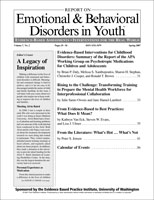Dealing With Bullying and Victimization in Schools
Author: Cynthia M. Hartung, Ph.D..; Douglas J. Scambler, Ph.D..
Source: Volume 06, Number 04, Fall 2006 , pp.77-82(6)

< previous article |next article > |return to table of contents
Abstract:
Concerns about school bullying and victimization have increased in the United States over the past decade. Bullying involves repeated episodes of confrontation when there is an imbalance of power between the perpetrator(s) and the victim(s). It can take many forms in addition to physical aggression and may include destruction of property, verbal aggression, sexual harassment, and social exclusion and manipulation. Studies of bullying incidents examining the behaviors not only of bullies and victims but also of peer bystanders have found that the behaviors of peer bystanders can have important consequences when bullying incidents occur. Peers may inadvertently reinforce the bully by quietly observing the incident, but efforts by peer bystanders to end the bullying are usually successful. For this reason, many intervention programs focus on making peer bystanders aware of the impact of their behaviors. Programs need to be school-wide so that bystanders will have an atmosphere of support for intervening in bullying incidents. This article reviews issues related to bullying and victimization in schools. It defines concepts, reviews tools for assessing bullying, discusses interventions for decreasing bullying, and provides recommendations for future research.Keywords:
Affiliations:
1: Oklahoma State University; 2: Oklahoma State University.